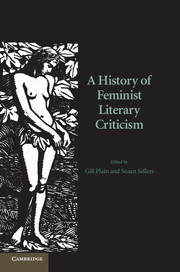Book contents
- Frontmatter
- Contents
- Acknowledgements
- Notes on contributors
- Introduction
- PART I PIONEERS AND PROTOFEMINISM
- Introduction to Part I
- 1 Medieval feminist criticism
- 2 Feminist criticism in the Renaissance and seventeenth century
- 3 Mary Wollstonecraft and her legacy
- 4 The feminist criticism of Virginia Woolf
- 5 Simone de Beauvoir and the demystification of woman
- PART II CREATING A FEMINIST LITERARY CRITICISM
- PART III POSTSTRUCTURALISM AND BEYOND
- Postscript: flaming feminism?
- Index
- References
3 - Mary Wollstonecraft and her legacy
Published online by Cambridge University Press: 05 June 2012
- Frontmatter
- Contents
- Acknowledgements
- Notes on contributors
- Introduction
- PART I PIONEERS AND PROTOFEMINISM
- Introduction to Part I
- 1 Medieval feminist criticism
- 2 Feminist criticism in the Renaissance and seventeenth century
- 3 Mary Wollstonecraft and her legacy
- 4 The feminist criticism of Virginia Woolf
- 5 Simone de Beauvoir and the demystification of woman
- PART II CREATING A FEMINIST LITERARY CRITICISM
- PART III POSTSTRUCTURALISM AND BEYOND
- Postscript: flaming feminism?
- Index
- References
Summary
INTRODUCTION
Although she is generally regarded as a writer of great influence for the development of feminist political thought and the feminist analysis of literary representations of women, Mary Wollstonecraft's work remains controversial. Particular attention has been paid to her alleged rejection or suspicion of sexuality, imagination and emotional expression. Cora Kaplan summarises the divergence of modern critical opinion on Wollstonecraft's life and work thus:
Was the erotic and affective imagination, gendered or universal, a blessing or a curse for women? Was it indispensable to radical consciousness, irrefutably a part of human psychic life, or was it something that could and should be jettisoned or retrained? If gendered identity was largely a matter of social construction … then could a brave new world reconstruct its unconscious as well as its conscious wishes?
(Kaplan, 2002: 259)Wollstonecraft struggled with these questions of identity, fantasy and desire, and her work shows the fierceness of the contest. Emerging in the shadow of the momentous changes in society and destruction of old and powerful institutions that the French Revolution represented, Wollstonecraft's writings reflected the urgency and excitement, and eventually the crushing despair, felt by all those who wished for, and acted to bring about, a ‘brave new world’. The Revolution, asserted Virginia Woolf, ‘was not merely an event that had happened outside her; it was an active agent in her own blood’, with all the contentions, contradictions and contesting for dominance that the metaphor suggests (Woolf, 1932/1986: 158).
- Type
- Chapter
- Information
- A History of Feminist Literary Criticism , pp. 46 - 65Publisher: Cambridge University PressPrint publication year: 2007
References
- 3
- Cited by



